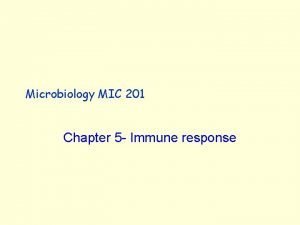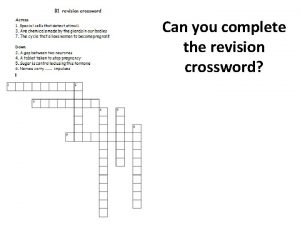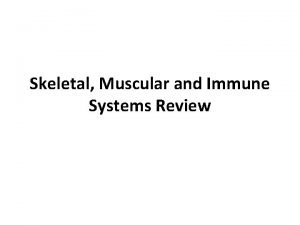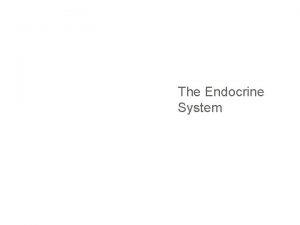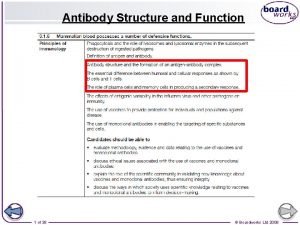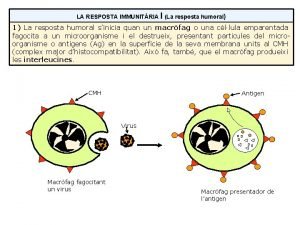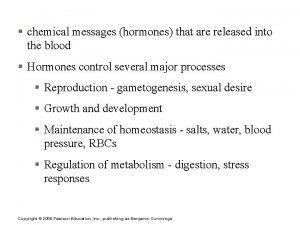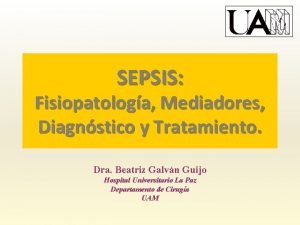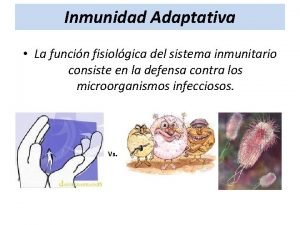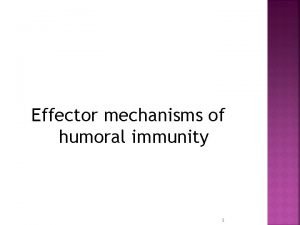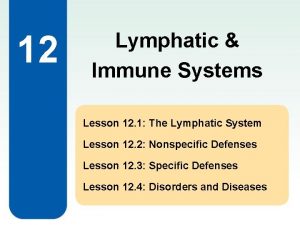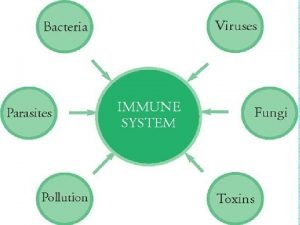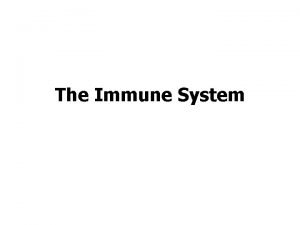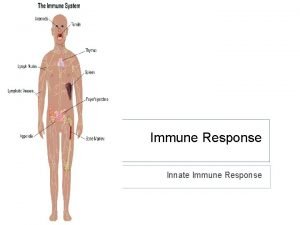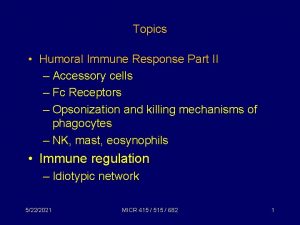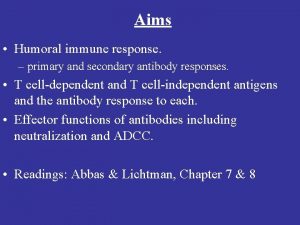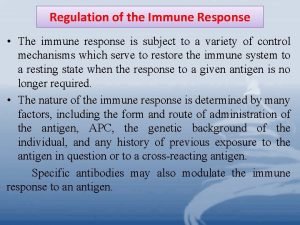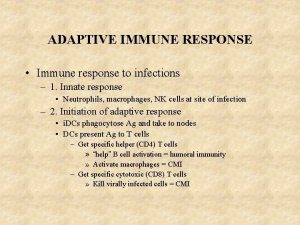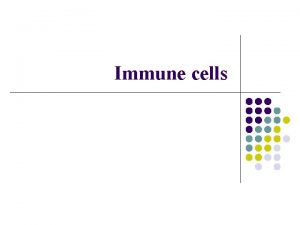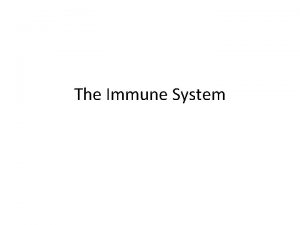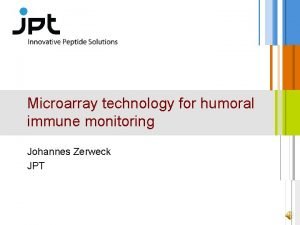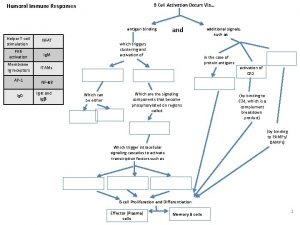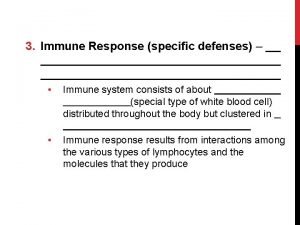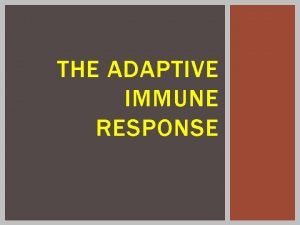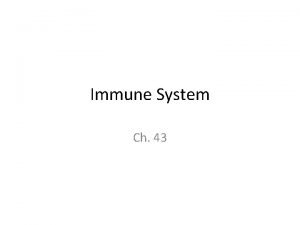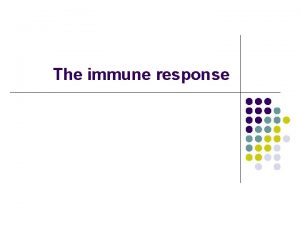The Immune Response The humoral response involves interaction

































- Slides: 33

The Immune Response The humoral response involves interaction of B cells with antigen (Ag) and their differentiation into antibody-secreting plasma cells. The secreted antibody (Ab) binds to the antigen and facilitates its clearance from the body. The cell-mediated responses involve various subpopulations of T cells that recognize antigen presented on self-cells. Helper T cells respond to antigen by producing cytokines. Cytotoxic T cells respond to antigen by developing into cytotoxic T lymphocytes (CTLs), which mediate killing of altered self -cells (e. g. , virus-infected cells).

The MHC class I pathway Antigen Proteasome Identifying of T-cell epitopes is important for development of peptide-based vaccines, evaluation of subunit vaccines, diagnostic development Peptides T-cell epitope ER MHC I Antigen Presenting Cell TCD 8+

The immunoglobulin fold Common Structures - Both the antibodies of the humoral response and the molecules involved in the cellular response (antibody, TCR, most CD [cell surface molecules expressed on various cell types in the immune system]) contain elements of common structure. The domains in these molecules are built on a common motif, called the immunoglobulin fold, in which two antiparallel sheets lie face to face. This structure probably represents the primitive structural element in the evolution of the immune response. The immunoglobulin fold is also found in a number of other proteins.

Complex Of A Human TCR, Influenza HA Antigen Peptide (PKYVKQNTLKLAT) and MHC Class II Epitope, or antigenic determinant, is defined as the site of an antigen T-Cell recognized Receptor by immune response molecules (antibodies, MHC, TCR) T cell epitope – a short linear peptide or other chemical entity (native or denatured antigen) that binds MHC V V I binds 8 -10 ac peptides; class II (class binds 11 -25 ac peptides) and may be recognized by T-cell receptor (TCR). MHC class II T cell recognition of antigen involves tertiary complex “antigen-TCR-MHC”. MHC class II 1 fyt Xenoreactive Complex AHIII 12. 2 TCR bound to P 1049 (ALWGFFPVLS) /HLA-A 2. 1 T-Cell Receptor V V MHC class I -2 -Microglobulin 1 lp 9


B cell epitope – a site on the surface of the antigen structure that binds antibody molecule. Protein antigens usually contain both sequential (or continues, they could work as epitopes even when a protein is denatured) and nonsequential (discontinues or conformational) epitopes. B cell recognition of antigen involves binary complex “native antigen-membrane immunoglobulin”. Different antibody recognize different epitopes. Most of the surface of a globular protein is potentially antigenic. Sperm whale myoglobin (1 vxg) contains five sequential epitopes (red, green, magenta, blue, orange) and two conformational epitopes (yellow, pink).

HIV-1 envelope protein gp 120 core complexed with CD 4 and a neutralizing human antibody 17 b The entry of HIV into cells requires the sequential interaction of the viral exterior envelope glycoprotein, gp 120, with the CD 4 glycoprotein and a chemokine receptor on the cell surface. These interactions initiate a fusion of the viral and cellular membranes. Although gp 120 can elicit virus-neutralizing antibodies, HIV eludes the immune system. 17 b epitope is comprised of four discontinuous -strands. HIV-1 envelope protein gp 120 (core fragment) CD 4 (N-terminal two domain fragment) 17 b epitope Antibody 17 b (Fab fragment) PDB: 1 gc 1

B cells and T cells recognize different epitopes of the same protein antigen T cell epitope B cell epitope Denatured antigen Native or denatured (rare) antigen Linear peptide 8 -30 ac Sequential or conformational Internal (often) Accessible, hydrophilic, mobile, usually on the surface or could be exposed as a result of physicochemical change Binding to T cell receptor: Kd 10 -5 – 10 -7 M (low affinity) Slow on-rate, slow off-rate (once bound, peptide may stay associated for hours to many days) Binding to antibody: Kd 10 -7 – 10 -11 M (high affinity) Rapid on-rate, variable off-rate

Types of protein-protein interactions (PPI) Non-obligate PPI Obligate PPI usually permanent the protomers are not found as stable structures on their own in vivo Permanent (most enzyme-inhibitor complexes) Transient Weak dissociation constant Kd = [A] [B] / [AB] (electron transport complexes) 10 -7 ÷ 10 -13 M Kd m. M- M Intermediate Non-obligate transient homodimer, Sperm lysin (interaction is broken and formed continuously) (antibody-antigen, TCR-MHC-peptide, signal transduction PPI), Kd M-n. M Strong Obligate heterodimer Human cathepsin D Non-obligate permanent heterodimer (require a molecular trigger to shift the oligomeric equilibrium) Kd n. M-f. M Thrombin and rodniin Bovine G protein dissociates into G and G subunits inhibitor upon GTP, but forms a stable trimer upon GDP

B cell (magenta, orange) and T cell epitopes (blue, green, red) of hen egg-white lysozyme PDB: 1 dpx

Immune Epitope Database and Analysis Resource IEDB, the newly developed public database by the LIAI together with the SAIC, UCSD, and Denmark University and sponsored by the NIH, maintains experimental data on immune epitopes (the sites on foreign molecules that are recognized by the immune system) curated from literature and submitted from the research community and provides analytical tools for epitope data analysis and their prediction in proteomes.

Agenda • Introduction to basic concepts of immunological bioinformatics. • Overview of the Immune Epitope Database (IEDB). • Case study #1. Prediction of peptide-MHC binding (Peters et al. A community resource benchmarking predictions of peptide binding to MHC-I molecules. PLo. S Comput Biol. 2006 Jun 9; 2(6): e 65): data compilation and prediction methods evaluation. • Case study #2. 3 D structure based prediction of antibody binding sites in proteins: data compilation and prediction methods evaluation.

The MHC class I pathway Antigen Proteasome Peptides T-cell epitope ER MHC I Antigen Presenting Cell TCD 8+

Performance measures for prediction methods TP FP FN threshold TN sensitivity = TP / (TP + FN) = 6/7= 0. 86 specificity = TN / (TN + FP) = 6/8 = 0. 75 AROC

Prediction of MHC class I epitopes ALAKAAAAM ALAKAAAAN ALAKAAAAV ALAKAAAAT GMNERPILT GILGFVFTM • Gibbs sampling • Sequence motifs, matrices • Sequence weighted matrices: performance of the method (measured as AROC) depends on the number of training peptides (”Immunological Bioinformatics” O. Lund, 2005) • Hidden Markov Models • Artificial Neural Networks TLNAWVKVV KLNEPVLLL AVVPFIVSV Peptides known to bind to the HLAA*0201 molecule. For T-cell epitopes the most selective requirement is the ability to bind an MHC with high affinity.

Assembling the dataset of measured peptide affinities to MHC class I molecules (Peters et al. A community resource benchmarking predictions of peptide binding to MHC-I molecules. PLo. S Comput Biol. 2006 Jun 9; 2(6): e 65) • Data: pairs {peptide – affinity value in terms of IC 50 n. M} for a given MHC allele • 48 different mouse, human, macaque, and chimpanzee MHC class I alleles. • Length pf peptides 8 – 11 aa. • If affinities for the same peptide to the same MHC molecule were recorded in multiple assays, the geometric mean of the IC 50 values was taken. • 84% of peptides differ in at least two residues with every other peptide in the dataset. • 48, 828 data points collected from two experimental groups.

An example of the problem of pooling experimental data from different sources • There is a good agreement between the measured affinity values by two experimental groups (Sette and Buus) for intermediate- and low-affinity peptides, less for high-affinity peptides. • For peptides with high affinity of 50 n. M or better the Matthews correlation coefficient is below 0. 37. • Important message: Pooling experimental data from different sources requires additional validation. High affinity Low affinity (IC 50 500 n. M – non-binder)

Peptide binding to MHC class I affinity prediction methods comparison (the same training and test data sets) Correlation coefficients (ARB=0. 55, SMM=0. 62, ANN=0. 69) are significantly different (p<0. 05 using a t test). Aroc values (ARB=0. 934, SMM=0. 952, ANN=0. 957) are significantly different (p<0. 05 using a paired t test on Aroc values generated by bootstrap).

Peptide binding to MHC class I affinity prediction methods comparison. Prediction performance as a function of training set size.

Peptide binding to MHC class I affinity prediction methods comparison (external tools: different training data sets) • Ideally the comparison should be done using ‘blind’ test set excluding every peptide used for any method training. Otherwise the performance of a method can be overestimated. • That was not done in the discussed work of Peters et al.

Agenda • Introduction to basic concepts of immunological bioinformatics. • Overview of the Immune Epitope Database (IEDB). • Case study #1. Prediction of peptide-MHC binding (Peters et al. A community resource benchmarking predictions of peptide binding to MHC-I molecules. PLo. S Comput Biol. 2006 Jun 9; 2(6): e 65): data compilation and prediction methods evaluation. • Case study #2. 3 D structure based prediction of antibody binding sites in proteins: data compilation and prediction methods evaluation.

HIV-1 envelope protein gp 120 core complexed with CD 4 and a neutralizing human antibody 17 b The entry of HIV into cells requires the sequential interaction of the viral exterior envelope glycoprotein, gp 120, with the CD 4 glycoprotein and a chemokine receptor on the cell surface. These interactions initiate a fusion of the viral and cellular membranes. Although gp 120 can elicit virus-neutralizing antibodies, HIV eludes the immune system. 17 b epitope is comprised of four discontinuous -strands. HIV-1 envelope protein gp 120 (core fragment) CD 4 (N-terminal two domain fragment) 17 b epitope Antibody 17 b (Fab fragment) PDB: 1 gc 1

Why is the knowledge of antibody epitopes is so important? • Vaccine design (immunogenicity, i. e. ability of vaccine to elicit in the naïve individual the production of pathogen neutralizing antibodies, is required): Ø Purified antigen (subunit) vaccines: • Inactivated toxins “toxoids”: tetanus toxoid, diphteria toxoid • Vaccines composed of bacterial polysaccharide antigens: flu, pneumococcus Ø Synthetic antigen vaccines: • hepatitus B (recombinant protein), herpes simplex virus • Diagnostic design (antigenicity, i. e. ability of synthetic antigen to be recognized by the original antibody, is required): • Autoimmune diseases: lupus, rheumatoid arthritis • Allergic reactions • Basic knowledge of antigenicity.

For fusion with its target cells, HIV-1 uses a trimeric Env complex containing gp 120 and gp 41 subunits. There are known four broadly reactive and neutralizing anti-HIV m. Abs (NAbs): b 12 (epitope on gp 120), 2 G 12 (epitope on gp 120, 2 F 5 (epitope on gp 41), 4 E 10 (epitope on gp 41). Other known m. Abs, 447 -52 D and 58. 2 (‘V 3 loop Abs’), 17 b, and X 5 (‘CD 4 i Abs’) have limited activity. “HIV vaccine design and the neutralizing antibody problem” Nature Immun. , 2004, 5, 233

Strategies for design immunogens that elicit broadly neutralizing antibodies (from “HIV vaccine design and the neutralizing antibody problem” Nature Immunology, 2004, 5, 233) To produce molecules that mimic the mature trimer Env on the virion surface. These molecules can be recombinant or expressed on the surface of particles such as pseudovirions or proteoliposomes. To produce Env molecules engineered to better present NAb epitopes than do “wild-type” molecules. To generate stable intermidiates of the entry process with the goal of exposing conserved epitopes to which antibodies could gain access during entry. To produce epitope mimics of the broadly NAbs determined from structural studies of antibody-antigen complexes.

Epitope identification The best precision in identification of antibody epitopes is provided by X-ray crystallography. Other methods to predict structure and location of antibody epitopes include: - mass spectrometry combined with immunoaffinity procedures; - screening of combinatorial phagedisplay peptide libraries; - mimitope approach: selection ligands from a library of random combinatorial ligands; - alanine scan; - etc.

Methods for antibody epitope prediction • Sequence-based (suitable for linear epitopes only) • Amino acid scales: hydrophobicity, secondary structure (beta-turn), polarity, flexibility, solvent accessibility etc. • The combination of scales and experimentation with several machine learning algorithms showed little improvement over single scalebased methods. • Maximum sensitivity is 59%. • Structure-based (antibody binding site prediction for a protein of a given 3 D structure): • CEP • Disco. Tope • Epitope mapping using peptide libraries

Performance measures for patch prediction methods • • • Sensitivity = TP / (TP + FN) - a proportion of correctly predicted epitope residues (TP) with respect to the total number of epitope residues (TP+FN). Specificity = 1 - FP / (TN + FP) – a proportion of correctly predicted non-epitope residues (TN) with respect to the total number of non-epitope residues (TN+FP). Positive predictive value (PPV) = TP / (TP + FP) - a proportion of correctly predicted epitope residues (TP) with respect to the total number of predicted epitope residues (TP+FN). TN=115 TN=165 220 aa FP=85 FN=5 TP=15 sensitivity = 75%, ppv = 15% specificity = 57. 5% FP=35 FN=5 TP=15 TN=190 sensitivity = 75%, ppv = 30% specificity = 82. 5% 220 aa sensitivity = 75%, ppv = 60% specificity = 95% FP=10 FN=5 TP=15 For a 80 aa protein Specificity=83%

The tool purpose Vaccine design: Diagnostic design: High sensitivity High specificity and PPV TN=200 TN=170 220 aa TP=20 FP=30 FN=0 220 aa TP=5 FP=0 FN=15 sensitivity = 100% sensitivity = 25% ppv = 40% ppv = 100% specificity = 85% specificity = 100%

Epitope prediction methods (CEP and Disco. Tope) have a tendency to be less specific than other methods.

Protein docking methods (DOT and Patch. Dock) in comparison with protein-protein binding site prediction methods (PPI-PRED and Pro. Mate) give better PPV at the same level of specificity.

Epitope prediction methods (CEP and Disco. Tope) show worse correlation between sensitivity and ppv than other methods (e. g. linear correlation coefficient r for CEP is 0. 48, for Disco. Tope (-7. 7) is 0. 51, whereas r for PPI-PRED is 0. 65, for CLus. Pro is 0, 88 and Patch. Dock is 0. 91).

 Primary immune response and secondary immune response
Primary immune response and secondary immune response Any substance capable of provoking an immune response
Any substance capable of provoking an immune response Cellular immune response
Cellular immune response Primary immune response
Primary immune response Cellular immune response
Cellular immune response Primary vs secondary immune response
Primary vs secondary immune response Unsaturated alcohol crossword clue
Unsaturated alcohol crossword clue Vaccinations help prepare the body to fight invasions of
Vaccinations help prepare the body to fight invasions of Primary vs secondary immune response
Primary vs secondary immune response Primary and secondary immune response
Primary and secondary immune response Stimulus humoral
Stimulus humoral La respuesta
La respuesta Humoral and cell mediated immunity difference
Humoral and cell mediated immunity difference Resposta humoral
Resposta humoral Thymosin and thymopoietin assist in the maturation of:
Thymosin and thymopoietin assist in the maturation of: Respuesta adaptativa humoral
Respuesta adaptativa humoral Antigenos virales
Antigenos virales Effector mechanism of humoral immunity
Effector mechanism of humoral immunity Respuesta adaptativa humoral
Respuesta adaptativa humoral Abbas
Abbas Endocrine system pearson
Endocrine system pearson Humoral patoloji paradigması
Humoral patoloji paradigması Cooper heron heward 2nd edition
Cooper heron heward 2nd edition Ap biology immune system
Ap biology immune system Lesson 12 blood and immune system
Lesson 12 blood and immune system 1what's the purpose of the body's immune system?
1what's the purpose of the body's immune system? Thymus immune system
Thymus immune system Defination of tuberculosis
Defination of tuberculosis Immune defintion
Immune defintion Immune system lymph nodes
Immune system lymph nodes Innate immunity first line of defense
Innate immunity first line of defense Immune system structure
Immune system structure Tdmu
Tdmu Ctl
Ctl




